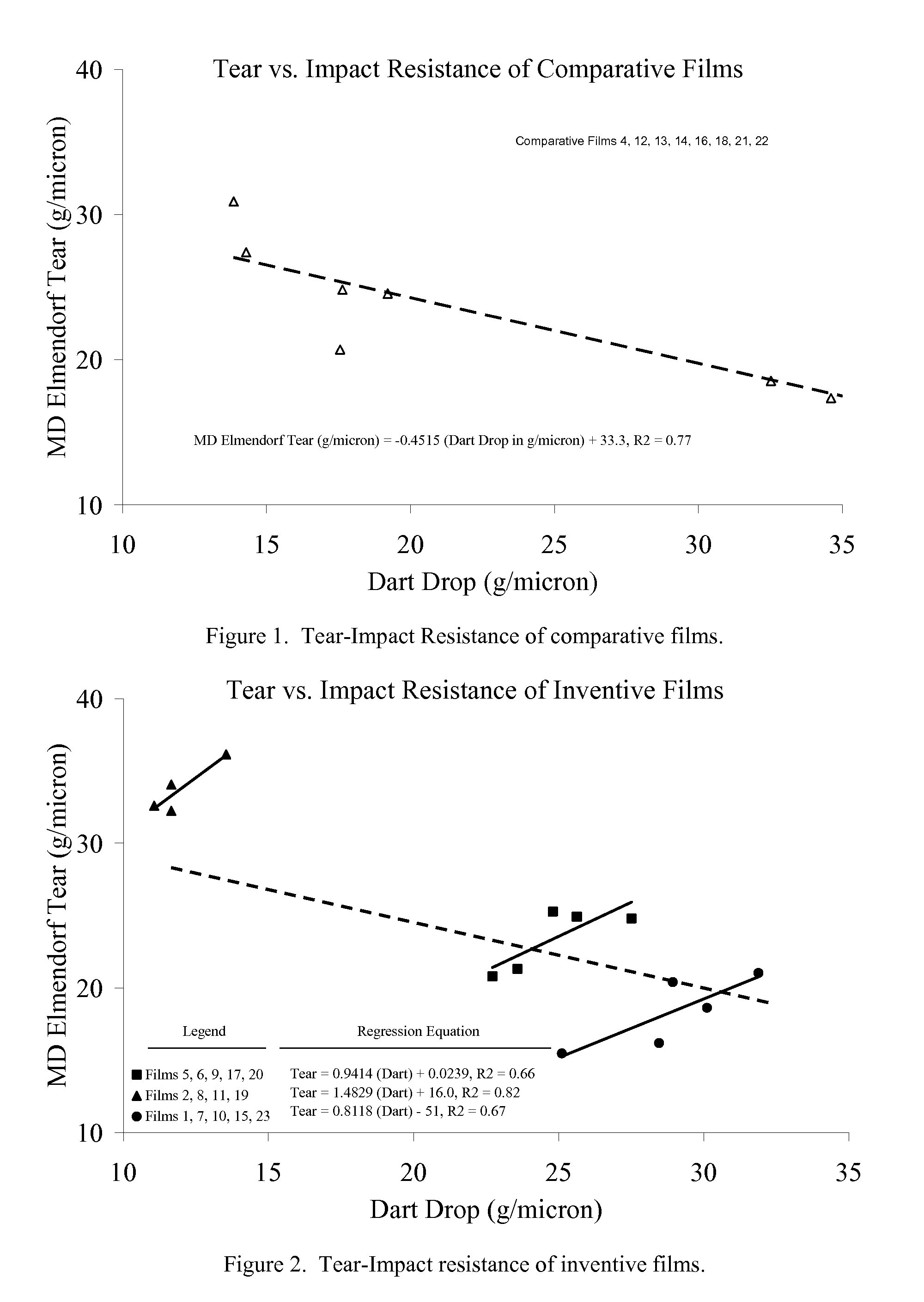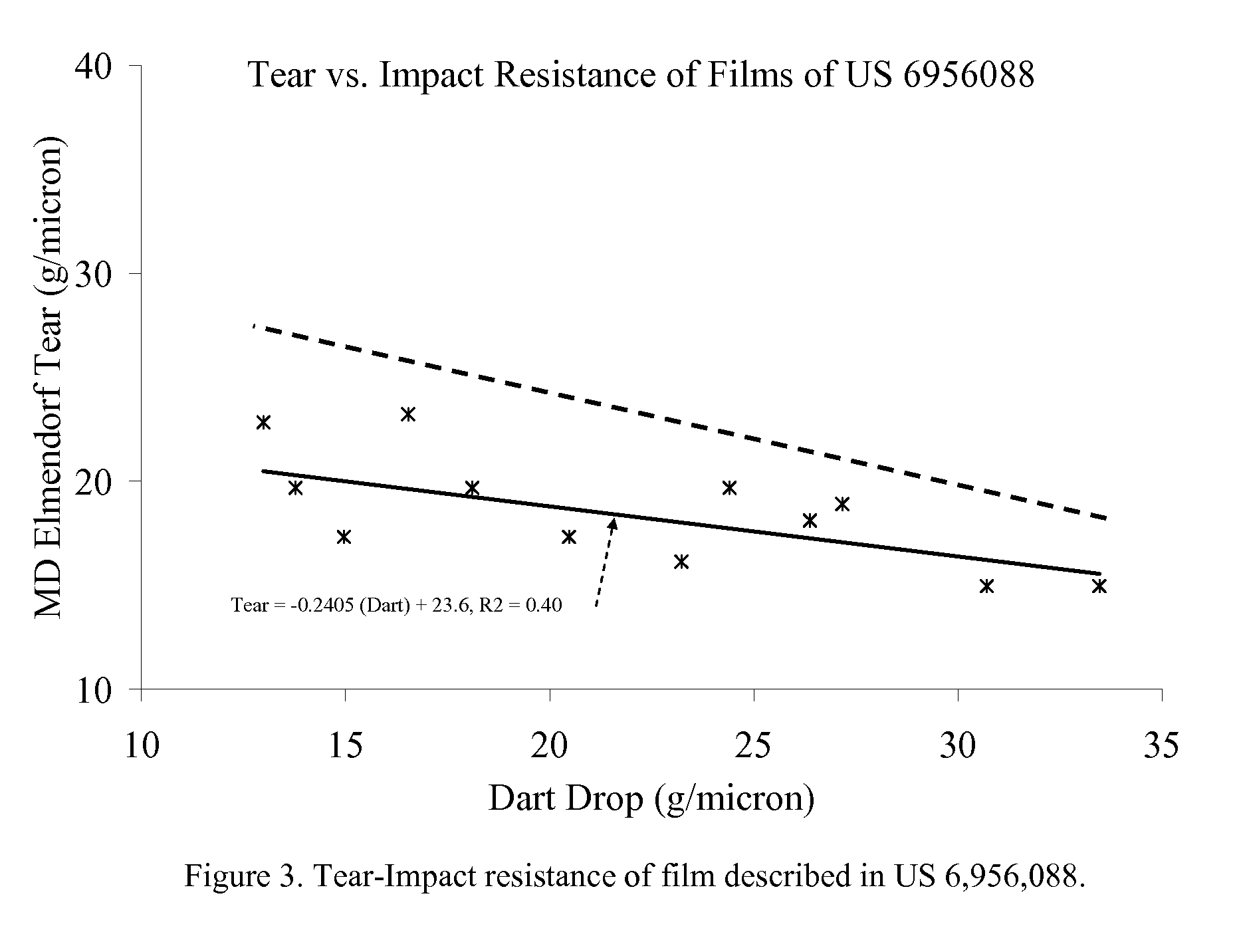Polyethylene Films and Process for Production Thereof
a technology of polyethylene films and polyethylene resins, applied in the direction of synthetic resin layered products, packaging, domestic packaging, etc., can solve the problems of low tear strength, low film stiffness, and in the machine and transverse film direction, and achieve good elmendorf and stiffness. good, the effect of good film stiffness
- Summary
- Abstract
- Description
- Claims
- Application Information
AI Technical Summary
Benefits of technology
Problems solved by technology
Method used
Image
Examples
example 1
[0217]A 0.7 g / cc melt index polyethylene resin (having 3 mol % hexene comonomer) with a Melt Index Ratio of 31.4 and a density of 0.921 g / cc produced using a supported catalyst prepared from bis(n-propylcyclopentadienyl) hafnium dimethyl (Boulder Scientific, Colorado, USA) and Ineos™ES757 (microsphereoidal silica with a 25 micron average particle size) with alumoxane (Al:Hf ratio 99:1) in a 5000 cubic foot (approx. 142,000 liters) Unipol reactor operated at 77° C. using an ethylene partial pressure of 200 psi (1.38 MPa), a ethylene to hexene ratio of 0.0150, and 10.0 mole percent isopentane (according to the basic procedures described in US 2008-0038533) was converted into thin (0.79 mil±0.005 mil / 20 micron±0.1 micron) three layered coextruded films using a W&H (Windmoeller and Hoelscher) blown film line equipped with a 9.8 inch (250 mm) die employing a 55 mil (1.4 mm) die gap (or an 87 mil (2.2 mm) die gap). The polyethylene resin is in all three layers of the film. The outside lay...
example 2
[0218]A 0.71 g / 10 min MI polyethylene resin (having 3 mol % hexene comonomer, a Melt Index Ratio of 32.4, density of 0.9205 g / cc, Mw / Mn of 3.77 and Mz / Mw of 2.69) produced following the methods described in U.S. Pat. No. 6,956,088 was converted into thin (20 micron±1.5 micron, 0.73 mil±0.06 mil,) monolayer films using a Sano blown film line employing a 60 mm (2.5 inch) smoothed bore 30:1 L / D extruder equipped with a 250 mm (10 inch) die operated using 2.5 blow up ratio. The polymer was fractionated and characterized as reported in Tables 18 to 22. The processing conditions for the films are reported in Table 23. The properties of the films are reported in Table 24.
TABLE 18Selected data on Molecular Weight Fractionations of Example 2FractionVariableUnitsParent12345678910Non-Solvent%—6053494744434241.941.340Recovery%10.95.09.09.06.87.015.49.29.718.2TREF TempPrimary Peak° C.92.690.691.892.592.492.592.492.292.492.394.4Secondary Peak° C.6076.476.976.776.352.952.657.75862.870.4Median Temp...
PUM
| Property | Measurement | Unit |
|---|---|---|
| Secant Modulus | aaaaa | aaaaa |
| density | aaaaa | aaaaa |
| processing time | aaaaa | aaaaa |
Abstract
Description
Claims
Application Information
 Login to View More
Login to View More - R&D
- Intellectual Property
- Life Sciences
- Materials
- Tech Scout
- Unparalleled Data Quality
- Higher Quality Content
- 60% Fewer Hallucinations
Browse by: Latest US Patents, China's latest patents, Technical Efficacy Thesaurus, Application Domain, Technology Topic, Popular Technical Reports.
© 2025 PatSnap. All rights reserved.Legal|Privacy policy|Modern Slavery Act Transparency Statement|Sitemap|About US| Contact US: help@patsnap.com



